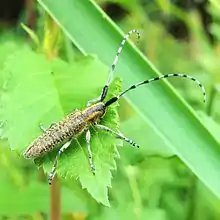Agapanthia villosoviridescens
Agapanthia villosoviridescens, also known as the golden-bloomed grey longhorn beetle,[1] is a species of beetle in the subfamily Lamiinae, found in the Caucasus, Europe, Kazakhstan, the Near East, Russia and Turkey.[2]
| Agapanthia villosoviridescens | |
|---|---|
 | |
 | |
| Scientific classification | |
| Domain: | Eukaryota |
| Kingdom: | Animalia |
| Phylum: | Arthropoda |
| Class: | Insecta |
| Order: | Coleoptera |
| Infraorder: | Cucujiformia |
| Family: | Cerambycidae |
| Subfamily: | Lamiinae |
| Genus: | Agapanthia |
| Species: | A. villosoviridescens |
| Binomial name | |
| Agapanthia villosoviridescens (De Geer, 1775) | |
Description and habitat
The beetle is named for its golden-black colour, with a golden bloom on its elytron and thorax. It reaches a length of 10–22 millimetres (0.39–0.87 in).[2]
Habitat
Their flight time is from May to August.[2] For the larval development the species is quite polyphagous with a wide variety of hosts, probably including Aconitum, Angelica, Anthriscus, Artemisia, Aster, Carduus, Cirsium, Chaerophyllum, Eupatorium, Foeniculum, Gentiana, Helleborus, Heracleum, Peucedanum, Salvia, Senecio, Urtica and Veratrum album.[2][3] The larvae develop in the stalks of the host plant, working their way down while growing, cutting off the stalk and creating pupal cells near ground level. Adults emerge through a newly cut exit hole in the side of the stalk.
References
- Common name
- Description, distribution, and habitat
- Bense 1995, as per forum post on waarneming.nl